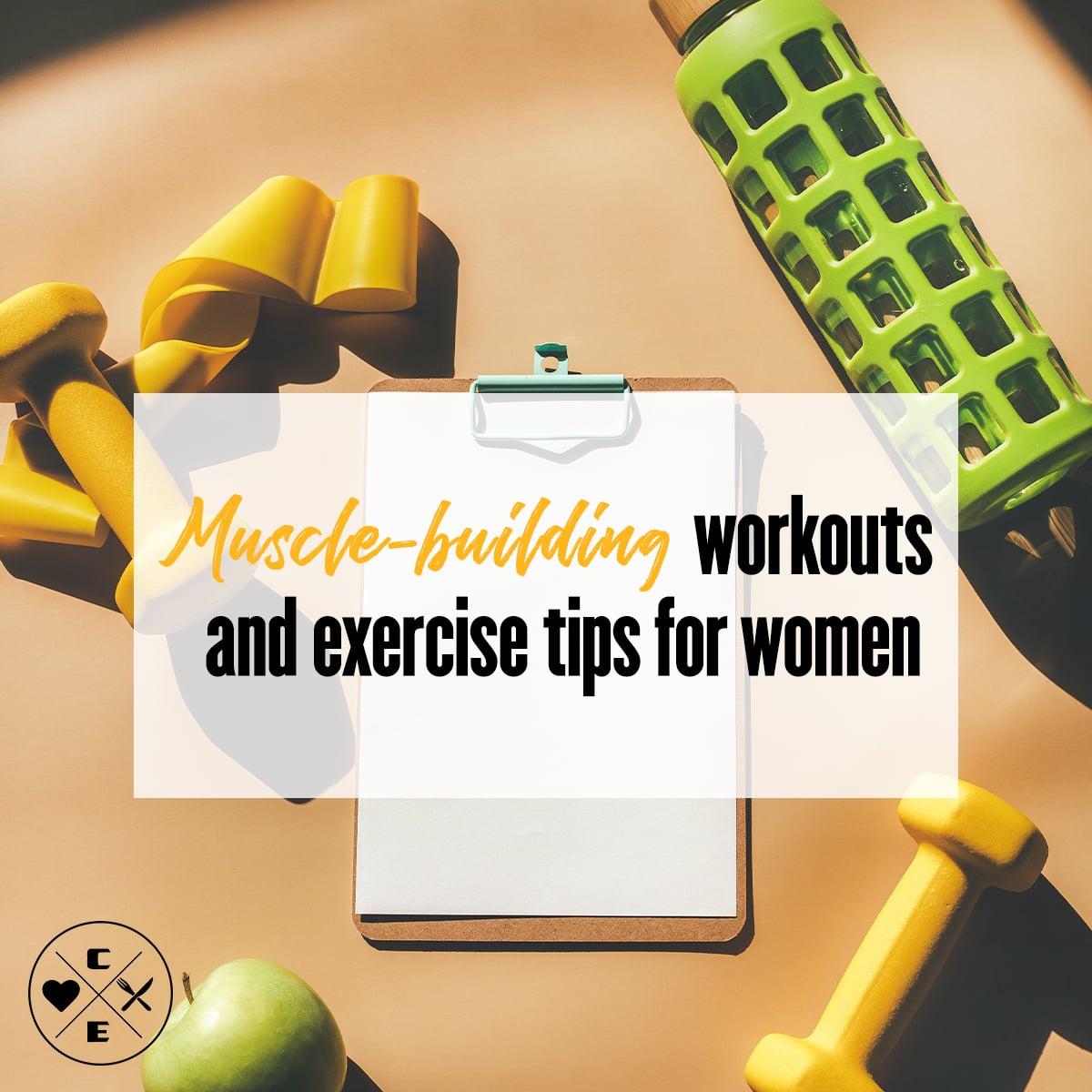
Exercise Tips for Women Trying to Build Muscle Through Workouts
Dorothy M. Shirnyl, RND
Exercises & Fitness
9 minute read
If you’re a woman and want to get stronger and build some muscle mass you’ve come to the right place, and those are some wonderful goals we want to help you achieve. Join us in today’s article to learn more about the specific training and exercise tips you should consider when picking a training plan or creating your own with our best training tips on building muscle and strength for women.
Why Should Women Train for Muscle and Strength?
Before we get into the exercise tips let’s first cover the reasons why lifting weights, and gaining muscle and strength is great for ladies:
You will not get too bulky: You should not worry about getting too muscular or having a disproportionate physique. If you train for strength and muscle you will actually develop a harmonious and nicely shaped hourglass body, with defined legs, and low body fat. Research shows that although the rate of muscle gain for men and women is quite similar, there is a natural limit for women based on their unique hormonal profile which prevents them from getting overly muscular without specific external aids, like hormonal therapy.
You won’t get injured: Actually, research shows that weightlifting has one of the lowest rates of injury among sports, just 1 injury per every 1000 hours of training
You will become strong, and independent and gain a lot of self-confidence: Every daily task will become easier when you get strong and you will be able to perform them with confidence and without help from others.
Special Training Considerations for Women
Here are a few exercise tips when choosing or crafting a training plan:
Women can recover faster from exercise: Women are able to recover their strength faster after a difficult workout than men, so they can fare well with a higher frequency of training for major muscle groups.
Women can and should train their legs a couple of times per week: Not only because it tends to be the body part women are more commonly interested in developing, but also because training your lower body allows for heavier weights, the higher release of growth hormone and other muscle stimulating processes in the body and also because research shows that the perfect training frequency for women is 2 to 4 days per week.
Women can and should train heavy: Women respond better to higher loads, around a 10 rep max and with rep ranges from 5-15 reps, where 6-8 is a safe sweet spot to gain strength and muscle and should devote most of their training to that rep range with heavy loads.
Women have unique hormonal considerations: Women also have to deal with menstrual cycles which can affect the rate of recovery taking longer to recover during the luteal phase (last half) of the menstrual cycle and faster recovery which can lead to larger strength gains and more muscle growth during the follicular phase (first half of the cycle). This means you should reduce the intensity and frequency of training during the luteal phase and can train harder and more often during the follicular phase.
The Best Workouts for Women
With all the mentioned considerations. Here are the best workouts you can do to get those strength and muscle gains:
Upper/Lower body split: Probably the best one as it allows you to train your lower body twice per week and has enough volume for your upper body as well. This requires you to train 4 days per week with one resting day in between. It looks like this:
- Monday - Lower: 3 sets of 6 to 8 reps of Barbell back squats and deadlifts each followed by 3 sets of 10-12 reps of Bulgarian split squats and leg curls each.
- Tuesday - Upper: 3 sets of 6 to 8 reps of barbell bench press, followed by 3 sets of 10-12 reps of dumbbell shoulder presses, incline dumbbell chest presses, and bent-over dumbbell rows each.
- Wednesday - Rest
- Thursday - Lower: 3 x 6-8 reps of hip thrusts and front squats each, followed by 3x10-12 of walking dumbbell lunges and Romanian deadlifts.
- Friday - Upper: 3x10-12 of overhead triceps extensions, barbell biceps curls, lateral dumbbell raises, and triceps pushdowns.
- Saturday - Rest
- Sunday - Rest
Full Body Split: Another great workout you can follow where you train the whole body at every session. You can do this 3 times per week and get great strength and muscle-building results:
- Monday - Full Body: 3 sets of 6 to 8 reps of barbell squats, barbell bench press, and Romanian deadlifts each. Followed by 3 sets of 10-12 reps of Seated cable rows.
- Tuesday - Rest
- Wednesday- Full Body: 3 sets of 10-12 reps of BUmbbell bench presses, Walking dumbbell lunges, wide lat pulldowns, and Lying leg curls.
- Thursday - Rest
- Friday - Full Body: #x6-8 of Barbell deadlifts and front squats, followed by 3x8-12 of bent-over dumbbell rows and cable triceps push-downs.
- Saturday and Sunday - Rest
Body Part split: This one is quite good as well but might not be the best for beginners or women with busy schedules. Still, your training session should not last longer than 45-60 minutes and you can get amazing results with the added volume. It looks like this
- Monday - Legs and Glutes: 3 sets of 6-8 reps for each of the following exercises. Barbell back squat, Barbell deadlift, lying leg curls, and Hip thrusts.
- Tuesday- Chest and Back: 3 sets of 6-8 reps of Barbell flat bench press, Incline dumbbell bench press, bent over dumbbell row, and seated cable row
- Wednesday - Legs and Calves: 3x6-8 of Romanian Deadlift, Walking lunges, Leg curls, and calf raises.
- Thursday - Arms, Shoulders, and Abs: 3x6-8 of dumbbell Shoulder press, dumbbell side lateral raise, overhead triceps extensions, and alternating biceps curls.
- Friday - Legs and Glutes: 3x 6-8 of Bulgarian split squats, Glute-ham raise, Machine abductor, and machine adduction.
- Saturday: Rest
- Sunday: Rest
If you want even more ideas, check our training section with a lot more training tips and routines.
Additional Training Tips for Women
Add some cardio to reduce body fat: The bulky women look you might be dreading is most likely due to increased body fat that gives a puffy oversized look, so adding a bit of fat-burning HIIT to your routine is one of the best exercise tips to make sure you get that toned, lean physique you are looking for with defined and toned legs, less fat around your midsection and arms and great posture. Reducing body fat is mostly dependent on the workout that you choose so stop asking yourself the dreaded question "how many calories should i eat to lose weight ?" and focus on exercise.
Include some pelvic floor training: This is particularly important for women to improve symptoms of urinary incontinence, reduce lower pelvis pain, have an easier and safer pregnancy, and even improve their sexual lives. You can find more about kegel exercises in our amazing article here.
You don’t need to join a gym just yet: Gyms can be scary and daunting places with lots of big people yelling and throwing weights around, so you can start right where you are with some home training and start building your strength and confidence before joining a gym. You can actually get great results at your own home gym without ever leaving your place.
Make sure to nurture your body: You should focus on great nutrition to fuel your workouts and give your body what it needs to build itself stronger with lots of protein, vegetables, healthy carbs, and fats. You can check out our meal plans to leave your nutrition intake in the hands of experts who can help you achieve all of your fitness goals with delicious foods delivered to you.
Final Thoughts
It isn't only about physical change when you embrace strength and muscle training; it's also a path toward improved health and empowerment. By incorporating these techniques and activities into your everyday routine, you'll feel more powerful, confident, and independent. The advantages go beyond the physical, as the mental toughness and self-assurance gained in the gym can have a favorable effect on a variety of elements of your life. So let's take the first step together to begin this powerful journey to a better and stronger you.
FAQ
What special factors should women consider while creating their exercise plans?
Their particular hormonal profile automatically limits muscle gain without the need for additional assistance, so they can perform muscle-building exercises without worrying about being overly bulky. Also, research demonstrates the safety of weightlifting and demonstrates its low injury risk. Strength training promotes independence in daily activities while also improving physical power.
What benefits may women get from integrating leg exercises in their training sessions?
Lifting higher weights during leg exercises increases the body's production of growth hormone and other mechanisms that stimulate the creation of new muscle. This is advantageous for weight management since it not only promotes muscle growth but also increases exercise-induced calorie expenditure. Leg muscle development enhances daily tasks like walking, climbing stairs, and lifting while lowering the chance of injuries.
How can women modify their workout plans to accommodate their menstrual cycles?
It is recommended to reduce intensity and frequency during the luteal phase, which covers the second half of the cycle and often includes delayed recovery. It's time for simpler workouts, flexibility exercises, and committed self-care. In contrast, a window of speedier recovery is provided by the follicular phase, which starts the menstrual cycle. In order to enhance strength and muscular gains, women can take advantage of this opportunity to push themselves with harder exercises, heavier weightlifting, and more intense training sessions.
How does a woman's hormonal makeup affect her propensity to grow muscle when strength training?
Women often have lower levels of testosterone, the main hormone responsible for muscular building, than do men. Because of this hormonal imbalance, women may not build muscle mass as quickly or significantly as males do. But the dominant female hormone estrogen can affect muscle growth by encouraging fat accumulation and perhaps impeding muscle protein synthesis.



